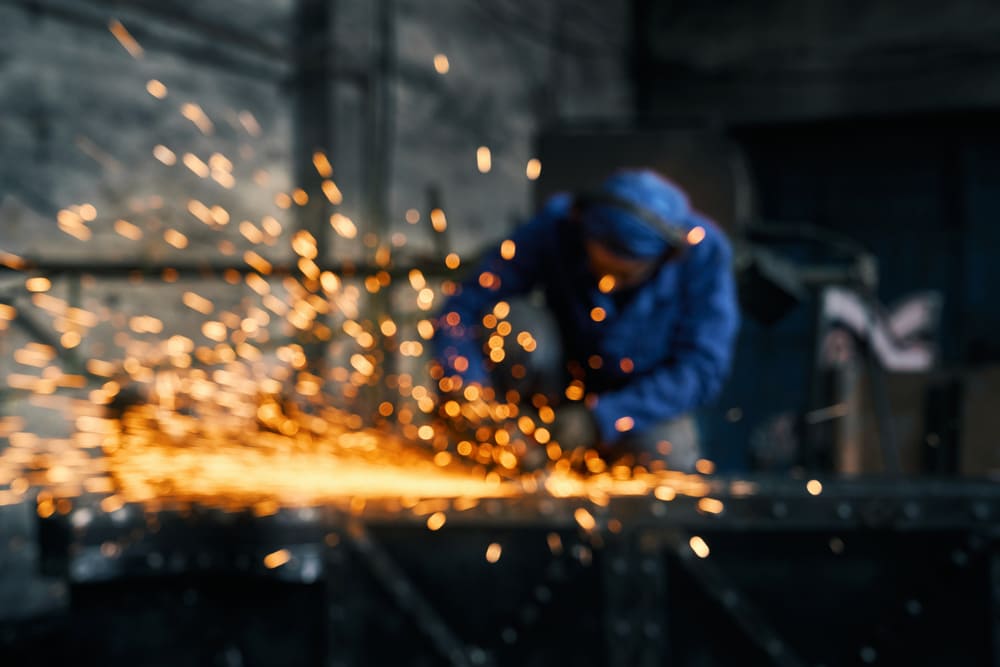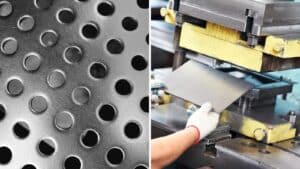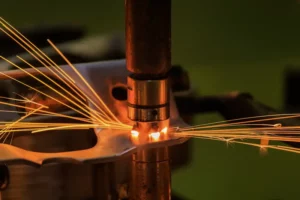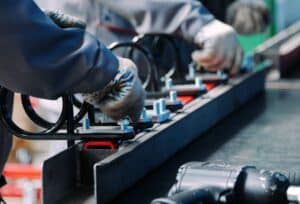The TIG welding (Tungsten Inert Gas), also known as Gas Tungsten Arc Welding or GTAW, is a type of arc welding with gas shielding that uses a non-consumable tungsten electrode and an inert gas to protect the weld bead.
At Beritch we are thoroughly familiar with this industrial technique, as we are experts in its execution. It is a high-precision process that allows for top-quality welds, especially suited for delicate materials such as aluminum, stainless steel, or titanium.
How TIG Welding Works
This welding is performed with a TIG torch. It works by creating an electric arc between the base metal and a non-consumable tungsten electrode. The intense heat generated melts the base metal and the filler material that is added during the process.
What is the Difference Between MIG/MAG and TIG Welding?
Each type of welding has specific uses. Therefore, there are some differences between MIG/MAG welding and TIG welding. These differences include:
- Electrode: TIG uses a non-consumable tungsten electrode; MIG/MAG uses a consumable wire.
- Quality and control: TIG offers greater precision and weld quality.
- Productivity: MIG/MAG achieves higher deposition rates due to its speed.
- Skill required: TIG requires greater welding expertise.
- Applications: TIG is used more in critical applications; MIG/MAG is more versatile.
- Costs: TIG equipment has a higher initial cost compared to MIG/MAG.
Gases Used in TIG Welding
Thanks to our experience in industrial welding, we understand the importance of gases as stabilizing agents, and we also know when welding can be done without gas.
The most commonly used gases in TIG welding are:
- Argon: provides a stable arc and allows higher welding speeds; it’s the most common gas in TIG. Suitable for carbon steels, stainless steels, and nickel alloys.
- Helium: offers higher arc temperature, recommended for metals with high thermal conductivity. More expensive than argon.
- Gas mixtures: such as argon-helium or argon-hydrogen, used to achieve specific properties for each application.
TIG Welding Without Gas
When welding certain materials, the use of shielding gas may not be necessary. This applies when welding aluminum or stainless steel, due to their self-cleaning properties.
To perform this type of welding, it is recommended to use high-quality welding machines and, most importantly, have expert personnel with deep knowledge of the process. Greater control is required than in conventional TIG welding since there is no gas protection.
TIG Welding With Filler
TIG welding with consumable filler must also be performed by trained and specialized personnel to ensure accurate and high-quality results, as it depends on various factors. The filler material is used to fill the joint and is usually made of the same material as the base metal. It can be added manually (electrode) or automatically (wire feeder).
At Beritch, we have trained and experienced welders for both types of welding. Our personnel are the guarantee of perfect metal joints.
TIG Welding Kit
Our welders are equipped with the best TIG welding kits. This equipment is essential as it allows high-quality welds on all metals — even those that are difficult to weld, and for welding thin metals or root passes in pipe joints.
TIG Welding Beads
We use TIG welding beads to join different materials. These beads have various applications, such as high-quality welding, welding of thin metals, hard-to-weld materials, joint welding, and all-position welding.
Types of TIG Welding
As manufacturers of metal parts, we work with various types of TIG welding. We select the most appropriate one for each case and apply it with maximum precision.
TIG Welding Methods
- Pulsed TIG: modulates the current to create weld spots for better control.
- Automatic TIG: automates the process using an orbital head or a positioning table.
- Keyhole TIG: used for deep and narrow welds.
- High-Amperage TIG: for welding sheets up to 300 mm thick.
Welding With Electrodes
- TIG Without Filler: only melts the base metal, no filler material used.
- TIG With Filler: filler material is added manually or automatically.
Welding with Electric Current
Depending on the type of electricity, we can perform two types of welding:
- AC TIG Welding: for welding aluminum and magnesium.
- DC TIG Welding: standard process for most metals.
GTAW Welding
Other types of TIG welding, or GTAW, that we perform include:
- Tubular TIG Welding: for circumferential welding of tubes and ducts.
- Orbital TIG Welding: rotation of the TIG head around a pipe.
TIG Spot Welding
TIG spot welding joins thin sheets by tack welding. It is characterized by applying small welds at specific spots, known as “spots”, to bond thin metal sheets together. These spots usually have a small diameter, around 2–5 mm.
TIG Welding
At Beritch we perform all types of TIG welding for different industrial uses. We carry them out daily as a necessary part of the production of various parts, and also provide them to our clients with the highest professionalism.
TIG Welding with Argon
We use argon welding in specific cases, as it:
- Allows high-quality and clean welds.
- Is suitable for welding thin materials.
- Offers great versatility for various metals and alloys.
TIG Welding on Aluminum
This is an ideal material for this type of welding:
- Ensures high strength and durability of welded joints.
- Produces no spatter and very little smoke.
- Enables good process control due to visibility of the weld pool.
TIG Welding on Stainless Steel
One of our most requested services. Welding this metal has some particular characteristics:
- Minimal distortion of the base material near the bead.
- Little need for post-weld finishing.
- Easily automatable process.
TIG Welding Parameter Table
When performing TIG welding, it is important to select the correct parameters according to the material, thickness, and welding position, among others. Some of the main parameters to adjust include:
- Current (amperage): usually between 15 and 250 A, depending on the job. The thicker the material, the higher the amperage required.
- Voltage: approximately between 10 and 30 V. Depends on material and current level.
- Welding speed: generally between 100 and 300 mm/min. Higher for thinner materials.
- Current type: direct or alternating; the latter is used for aluminum.
- Polarity: straight or reverse in DC welding.
- Gas flow rate: between 6 and 15 l/min is generally appropriate.
- Electrode diameter: from 1 to 4 mm depending on current intensity.
TIG Welding Temperature
The temperature during TIG welding greatly affects weld quality. Inadequate temperature can lead to defective joints. It determines key parameters such as penetration, weld pool size, and cooling speed.
TIG Welding Amperage Table
At Bericht, as experts in this industrial technique, we work with parameter tables to perform TIG welding with the highest precision and safety. These tables indicate the appropriate values for current, voltage, speed, and other parameters based on the thickness and material to be welded.
Frequently Asked Questions About TIG Welding
What is TIG welding and what is it used for?
TIG welding (Tungsten Inert Gas) is an arc welding process that uses a non-consumable tungsten electrode and an inert gas to shield the weld. It is commonly used to weld delicate materials like aluminum, stainless steel, and titanium due to its high precision and quality.
What are the advantages of TIG welding compared to other types of welding?
TIG welding offers greater precision and control, producing high-quality welds. Although it is slower and requires more skill than MIG/MAG welding, it is ideal for critical applications and delicate materials. It also produces no spatter and allows precise heat control.
What types of gases are used in TIG welding and why?
The most commonly used gases in TIG welding are argon and helium. Argon is the most popular, providing a stable arc and allowing higher welding speeds. Helium is used for metals with high thermal conductivity due to its higher arc temperature. Gas mixtures like argon-helium are also used for specific applications.
Is it possible to perform TIG welding without gas?
Yes, in certain specific cases, such as welding aluminum or stainless steel, TIG welding can be performed without gas due to the self-cleaning properties of these materials. However, it requires very precise control and experience since gas protection is not present.
What equipment is needed for TIG welding?
Basic TIG welding equipment includes a TIG welder, a TIG torch, a tungsten electrode, and a supply of inert gas such as argon. Depending on the application, filler material may also be required, which can be added manually or through an automatic feeder.
What are the most common applications of TIG welding?
TIG welding is commonly used in the aerospace and automotive industries, and in the manufacturing of high-precision products. It is ideal for welding thin metals, performing root welds in piping, and joining hard-to-weld materials like aluminum and stainless steel.




